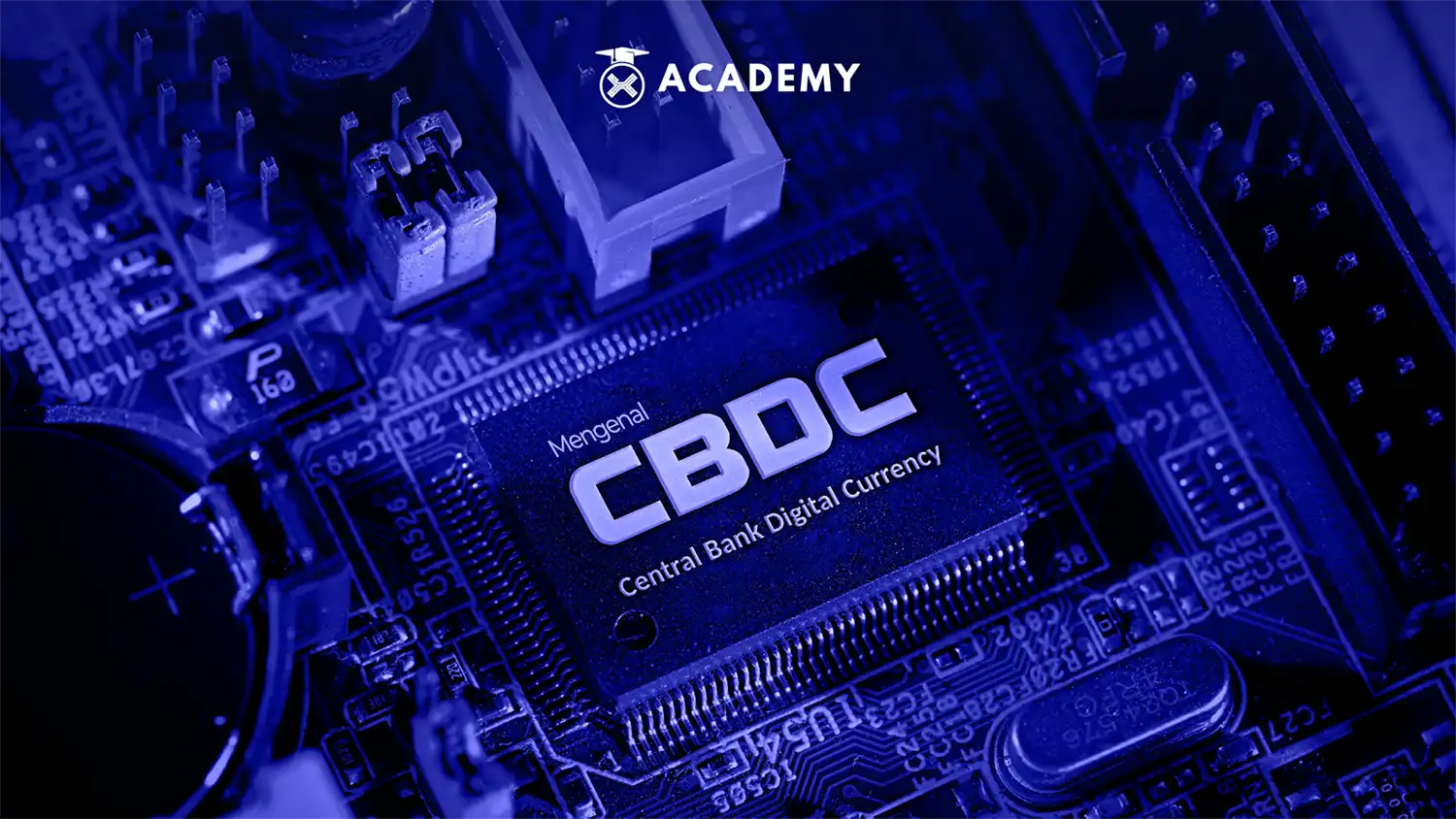Indodax friends, do you know yet? In July 2023, Bank Indonesia published a written plan for developing a new form of digital Rupiah currency. This digital Rupiah money is regulated by Bank Indonesia and, of course, uses blockchain technology in its application.
The question is, What is digital Rupiah? How is it different from the money in our savings accounts & digital wallets?
How is it different from crypto-stable coins, which also use blockchain technology?
Let’s examine in full what CBDC is, how it will be used in the future, and the difference with crypto assets.
What is CBDC?

CBDC, commonly known as Central Bank Digital Currency, is a form of digital currency issued and regulated by the central bank as the regulator in a country. Basically, CBDC functions as an official and legal means of payment and has the same legal status as conventional currency such as cash.
The central bank has an important role in issuing and managing CBDC to maintain the stability of the country’s financial system & meet people’s needs in terms of electronic payments.
As part of an official financial system regulated by the government, CBDC has several special characteristics, such as:
- It is the direct responsibility of the central bank to comply with monetary policy so as to provide guarantees for the stability of the value of the currency.
- Through the application of digital technology, the use of CBDC can become more efficient, fast, safe, and transparent.
- Implementation of CBDC helps reduce dependence on conventional payment methods such as cash, thereby increasing financial inclusion by providing access to thosewho do not have access to traditional banking services.
Main Purpose of CBDC
Maybe you ask, Why does a central bank like Bank Indonesia issue digital Rupiah? Isn’t there already electronic money and paper money?
The answer is, of course, because digital money can be a modern solution to various problems in the payment system and financial infrastructure of a country, such as Indonesia, which is not yet efficient.
From your point of view, as someone who lives in a big city, you may feel that the payment infrastructure is quite complete. However, if you look at it from the perspective of the entire population of the Republic of Indonesia, the payment system in the country is not yet efficient. Currently, national banking has its own digital system, but it is still separate, so it cannot be monitored in one interconnected system.
The main goal of CBDC is to generate innovation in financial payment systems that can improve efficiency, transparency, and accessibility for society.
One of the many reasons several countries are interested in developing CBDC is to anticipate increasingly dynamic technological developments and shifting trends in payment systems.
It doesn’t stop there; CBDC development can also help increase financial inclusion. With easy access to digital currency supported by the central bank, people with limited access to traditional financial services can more easily carry out digital transactions such as payments and fund transfers.
List of Countries Implementing CBDC
The following is a list of countries that are implementing CBDC.
1. Sweden
Through the Swedish Central Bank, Riksbank continues to experiment with e-krona as a CBDC, aiming to address the decline in cash use in the country.
2. China
The Central Bank of China, or People’s Bank of China (PBOC), has developed e-RMB, or digital yuan, as a CBDC.
3. Singapore
Project Ubin is the name of the CBDC projection made by the Monetary Authority of Singapore (MAS) in synergy with various financial sectors to study potential opportunities and risks from using CBDC.
4. Bahamas
This country, which consists of more than 700 islands in the Lucayan Sea, Caribbean, launched a CBDC called Sand Dollar in 2020 through its central bank (Central Bank of the Bahamas).
In terms of regulation and control, CBDCs are regulated and supervised by central banks, while crypto assets are not due to their decentralized nature.
The central bank’s main consideration for implementing CBDC is maintaining financial stability and reducing security risks, so of course the regulations issued are quite strict to mitigate risks that arise, for example, cyber attacks.
Meanwhile, crypto assets, on the other hand, are not regulated by certain parties, such as central banks. This makes crypto assets more vulnerable to the risk of fraud, money laundering, and other illegal activities.
In terms of conventional currency, CBDC is another form of conventional or fiat currency such as the rupiah and the dollar, while crypto assets have unique characteristics.
The value of crypto assets continues to fluctuate over a certain period of time. Crypto assets can also be used as commodities for transactions, but they do not have support from the government or central bank.
Benefits and Drawbacks of CBDC

CBDC implementation has potential benefits that have a significant impact on the economy and financial system, including:
Security and transparency
CBDC can provide a more sophisticated level of security for transactions, allowing central banks to track the use of money more accurately.
Transaction efficiency
The implementation of CBDC can accelerate payments and direct fund transfers between individuals and financial institutions, cutting costs and the time required.
-
Solution to decreasing cash use
CBDC can be the answer for countries experiencing a decline in the use of cash because it is practical, safe, easy, and cheap.
-
Monetary policy control
CBDC can provide a way for the country’s central bank to take control of implementing monetary policy, for example, by adjusting the country’s benchmark interest rate.
The development of Central Bank Digital Currency (CBDC) will certainly encounter challenges and risks that need to be seen and mitigated, including:
-
Regulations that are comprehensive
Policy coverage ranges from regulation and consumer protection to the prevention of abuse or violations of the law.
-
Data Privacy
With advantages such as fast and easy transactions, of course data privacy must be a top priority so that users’ personal information cannot be misused by irresponsible parties.
-
Data Security
Digital payment systems have the potential for cybercrime risks such as data theft and manipulation, so a strong and sophisticated security network is needed.
Public acceptability and literacy in CBDC
Education is needed for the wider community regarding literacy and understanding regarding the benefits and risks of CBDCs because the success of a CBDC certainly depends on its users.
Conclusion
CBDC and crypto assets are two types of digital assets that, of course, have differences from one another. While CBDCs are overseen by the nation’s central bank and are another form of fiat currency, cryptocurrencies are decentralized.
This inequality has an important direct impact on the financial system. CBDCs can increase the monetary stability and security of the financial system, while crypto assets can improve the efficiency and accessibility of payment systems.
Even though they are different, there is still a link between CBDC and crypto assets, namely that both use blockchain technology. Blockchain technology allows these two types of digital money to be recorded, distributed safely, and traded transparently.
It doesn’t stop there; CBDC and crypto assets have implications and play an equally important role in the development of the digital economy. If CBDC can be used to increase the efficiency of the payment system, it will increase public access (inclusive) to financial services.
Meanwhile, crypto assets can encourage financial technology innovation, such as payment transactions in the blockchain world, for example, for purchasing digital work assets such as NFTs.
Are You Interested In Investing In Crypto Assets?
So, how is it? Do you understand more about the differences and similarities between CBDC and crypto assets? Speaking of digital assets, this can be your reference for increasing investment diversification by starting to buy digital assets.
So, if you are interested in investing in crypto, you should be able to download the best and most trusted crypto application that has been strictly regulated by the government—yes, only on Indodax—as your future asset choice!
If this article makes you more understanding and smarter, don’t keep this information to yourself, share it with your friends too!





 Polkadot 8.92%
Polkadot 8.92%
 BNB 0.40%
BNB 0.40%
 Solana 4.83%
Solana 4.83%
 Ethereum 2.37%
Ethereum 2.37%
 Cardano 1.35%
Cardano 1.35%
 Polygon Ecosystem Token 2.12%
Polygon Ecosystem Token 2.12%
 Tron 2.85%
Tron 2.85%
 Market
Market


